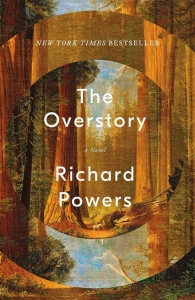When the lateral roots of two Douglas-firs run into each other underground, they fuse. Through those self grafted knots, the two trees join their vascular systems together and become one. Networked together underground by countless thousands of miles of living fungal threads, her trees feed and heal each other, keep their young and sick alive, pool their resources and metabolites into community chests….There are no individuals. There aren’t even separate species. Everything in the forest is the forest.
Networked together underground by countless thousands of miles of living fungal threads, her trees feed and heal each other, keep their young and sick alive, pool their resources and metabolites into community chests….There are no individuals. There aren’t even separate species. Everything in the forest is the forest.
This is my first Richard Powers book, offered to me by my wife and what a good present, this man is an encyclopedia of knowledge about trees. He approaches this book, the story of our relationship with the natural world seen through the particular relationship with trees, the danger we represent to trees and thus ultimately to ourselves through the often intertwining individual lives of a number of people that one way or another fight for their environment and at the same time embarks on the history of trees in North America since the arrival of the Europeans.
There is Nicolas Hoel whose family moved from the east coast to Iowa where land was given away and who successfully planted and grew a chestnut tree so many miles from its normal habitat and the amazing project begun by his great grandfather and continued by each generation to take a photo of this tree once a month from the same spot, making it possible by flicking through the photos for humans to appreciate the slowed down life of a tree. We also hear of the parasite that wiped out all of American chestnut trees:
Death races across Connecticut and Massachusetts, jumping dozens of miles a year. Trees succumb by the hundreds of thousands. A country watches dumbstruck as New England’s priceless chestnuts melt away. The tree of the tanning industry, of railroad ties, train cars, telegraph poles, fuel, fences, houses, barns, fine desks, tables, pianos, crates, paper pulp, and endless free shade and food —the most harvested tree in the country—is vanishing.
There is Olivia Vandergriff, an East coast student who dies electrocuted and recovers and follows voices in her head knowing that they will dictate her life. Her meeting with Nicolas Hoel sparks a bond that sends them to the Oregon forests to fight for trees, once spending a year up a particular fir without coming down to try to slow down the logging industry which had already cut down more than 95% of Americas original forests and which is now clear cutting the Douglas firs.
There are Douglas Pavlicek, a war veteran with a Purple Heart and Mimi Ma who wind up together in the same camp in the same forest war, Douglas one day understands what is happening around him and that he has been too blind to see:
Douglas Pavlicek sees slabs of light through the trunks where there should be shadow all the way to the forest’s heart….He stops at a gas station to tank up. He asks the cashier, “Have they been clear-cutting up the valley?”
The man takes Douggie’s silver dollars. “Shit yeah.”
“And hiding it behind a little voter’s curtain?”
“They’re called beauty strips. Vista corridors.”
There is also Patricia Westerford the biology professor who, too early, learns that trees communicate between themselves as illustrated in the opening quote and whose work is derided by the establishment before being accepted decades later.
We follow these characters and others, that I found much less interesting, through their different lives, Westerford approving non violence and then the first four, Hoel, Vandergriff, Pavlicek and Ma moving over to direct action leading eventually to the death in an explosion of one of them as they are attacking a logging base, and the effect this tragedy has on their lives.
The trees will still be there when we’ve gone. A powerful book, will make you want to fight for nature.
First Published in English as “The Overstory” in 2018 by W. W. Norton & Company.